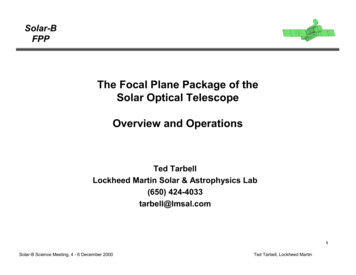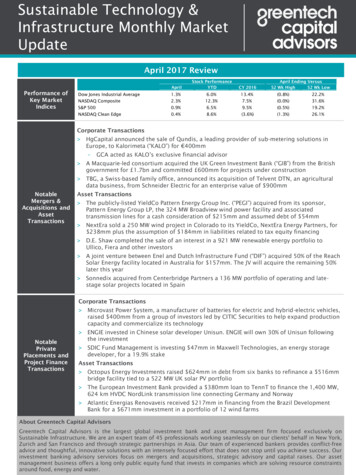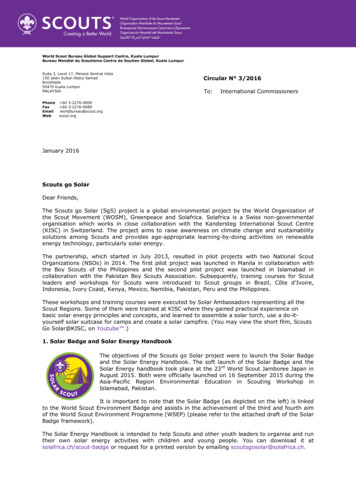
Transcription
Solar-BFPPThe Focal Plane Package of theSolar Optical TelescopeOverview and OperationsTed TarbellLockheed Martin Solar & Astrophysics Lab(650) 424-4033tarbell@lmsal.com1Solar-B Science Meeting, 4 - 6 December 2000Ted Tarbell, Lockheed Martin
Solar-BFPPThe Solar-B Mission GoalsThe primary goal of the Solar-B mission is toadvance our understanding of the origin ofthe outer solar atmosphere, the corona, andof the coupling between the fine magneticstructure at the photosphere and the dynamicprocesses occurring in the corona.Solar-B is a Japanese national science project withinternational cooperation from the US and UK.2Solar-B Science Meeting, 4 - 6 December 2000Ted Tarbell, Lockheed Martin
Solar-BFPP Solar-B OverviewSolar-B will be launched from Japan in summer, 2005– Solar Optical Telescope (SOT) -- 50 cm Gregorian Telescopeprovided by ISAS–– Built by Mitsubishi Electronics Company for ISAS & NAOJJapanese PI Prof. Saku TsunetaFocal Plane Package (FPP) -- Spectropolarimeter and FiltergraphInstrument provided by NASA–– Prof. Takeo Kosugi of ISAS is the Solar-B Project Manager and PIBuilt at LMSAL in collaboration with HAOUS PI Alan TitleOther Solar-B Instruments––X-Ray Telescope (XRT), by ISAS and NASA (SAO, Leon Golub is US PI)EUV Imaging Spectrometer (EIS), by UK, ISAS, and NASA (NRL, GeorgeDoschek)3Solar-B Science Meeting, 4 - 6 December 2000Ted Tarbell, Lockheed Martin
Solar-BFPPFPP Science Goals Magnetic Flux Transport– Observe how magnetic flux emerges, disperses & disappears fromthe solar surface, including weak intranetwork fields (B 400 G).– Determine whether magnetic field is generated in or near thesurface: fast dynamo action. Scales of Convection– Investigate the relationship of the granulation, mesogranulation,and supergranulation. Sunspots and Active Regions– Measure the vector magnetic field of sunspots and plage areas.– Observe the formation, dynamics & decay of entire active regions Upper Atmospheric Connections– Determine the role of the surface magnetic field on the structureand dynamics of the outer atmosphere Solar Cycle Evolution– Measure the effect of active regions on the solar cycle irradiancemodulation.4Solar-B Science Meeting, 4 - 6 December 2000Ted Tarbell, Lockheed Martin
Solar-BFPPLevel 1 Requirements Spatial Resolution 0.25 arcseconds– Preserve imaging quality of SOT from 3880 — 6600 Å. Field of view 200 x 100 arcseconds– Capture entire active region and significant portions ofsurrounding quiet network. Image stabilization system 0.02 arcseconds– Stabilize S/C jitter to 0.02 arcsec over range of 2 — 20 Hz. Science Instruments– Narrowband Tunable Filter: better than 1% precision magnetograms– Broadband Filter Instrument: 0.2 arcseconds 3880Å– Spectro-Polarimeter: better than 0.1% precision Stokes vectormeasurements.5Solar-B Science Meeting, 4 - 6 December 2000Ted Tarbell, Lockheed Martin
Solar-BFPPSample FPP Data6Solar-B Science Meeting, 4 - 6 December 2000Ted Tarbell, Lockheed Martin
Solar-BFPPSOT Major Components SOT: Solar Optical Telescope OTA: Optical Telescope Assembly1/2-meter class for 0.2 arcsecond spatial resolution at 5000 Å.Axisymmetric design for minimal instrumental polarization. PMU: Polarization Modulator UnitRotating waveplate for polarization modulation before any obliquereflections. TTM: Tip/Tilt MirrorPZT- actuated folding mirror for image stabilization.7Solar-B Science Meeting, 4 - 6 December 2000Ted Tarbell, Lockheed Martin
Solar-BFPPFPP Major Components FPP: Focal Plane Package NFI: Narrowband Filter ImagerTunable Birefringent filter: 0.1 Å bandwidth, vector magnetograph.Data similar to the SOUP filter images from La Palma, with highersensitivity and spatial resolution. BFI: Broadband Filter ImagerInterference filters for short exposures and highest image quality.Data similar to G- band movies from La Palma, with perfect seeing. SP: Spectro-PolarimeterFe I 6301/2Å lines: dual-line dual-polarization spectra for high precisionStokes polarimetry.Data similar to HAO Advanced Stokes Polarimeter, with much higherspatial resolution. CT: Correlation TrackerJitter sensor for image stabilization with tip/tilt mirror.8Solar-B Science Meeting, 4 - 6 December 2000Ted Tarbell, Lockheed Martin
SOLAR-B SYSTEMFINITE ELEMENT MODELSolar-BFPPXRTFPPS/C BUSOBU9Solar-B Science Meeting, 4 - 6 December 2000Ted Tarbell, Lockheed Martin
Solar-BFPPFPP Instrument - Y Side10Solar-B Science Meeting, 4 - 6 December 2000Ted Tarbell, Lockheed Martin
Solar-BFPPOptical Schematic of SOT/FPPLitrow MirrorFolding MirrorDual256192xx10241024CCDCCDPolarizing BSX3 Mag lensPolarizing BSFolding MirrorSlitGratingPreslitFolding MirrorShutterField lensField lensX2 Mag lensShutterFilterwheelTelecentriclensesBeam DistributorBirefringent Filter2048 x 4096 CCDField MaskFilterwheelSecondary50 x 50 CCDReimaging LensFolding MirrorDemag lensImage Offset PrismsFolding MirrorPolarizationModulatorPrimaryCLUTip Tilt MirrorOTACommon OpticsCTNFIBFISP11Solar-B Science Meeting, 4 - 6 December 2000Ted Tarbell, Lockheed Martin
Solar-BFPPPMU System Overview Polarization Modulator: Rotating Waveplate– Immediately follows telescope for minimal instrumental polarization.– Quartz substrate retarder.– Optimized retardation for linear and circular polarization at 6302 Å and5173 Å .– 1.6 second rotation period.– DC hollow core motor - continual operation throughout mission lifetime.– Multiple wedged optics to minimize beam wobble and reduce fringing. Tip/Tilt Mirror System– ISAS/NAOJ/MELCO design and manufacture.– Provides 2-axis image stabilization of 0.02 arcseconds up to 20 Hzbandwidth.12Solar-B Science Meeting, 4 - 6 December 2000Ted Tarbell, Lockheed Martin
Solar-BFPPSP System Overview Littrow design– Off-axis parabolic mirror. Slit: 160” x 0.16”– Maximum map FOV 320” x 160”– Dual-beam polarization analysis– Calcite prism gives provides both modulated polarizationssimultaneously for minimum crosstalk. Fe I 6301.5 Å (g 1.67) and 6302.5 Å (g 2.5) lines Spectral resolution 25 mÅ Spectral range 2 Å Polarization precision better than 0.1 % Polarization S/N for map 10313Solar-B Science Meeting, 4 - 6 December 2000Ted Tarbell, Lockheed Martin
Solar-BFPPSP Observing Modes Normal Mapping Mode– Expose/read/demodulate for 3 modulator rotations (4.8 seconds).– Move the slit one step of 0.16 arcsec (0.2 sec).– Raw data rate 200 kPixels/sec.– Send to MDP for compression and downlink.– 160” raster takes 80 minutes, 320” raster takes 160 minutes Fast Map Mode– 0.32” spatial resolution, 3.4 seconds per slit position– 5.1” raster takes 55 seconds, 160” raster takes 30 minutes Other modes have higher cadence or higher sensitivity14Solar-B Science Meeting, 4 - 6 December 2000Ted Tarbell, Lockheed Martin
Solar-BFPPComparison of ASP andFiltergraph MagnetogramsStokes Longitudinal Magnetogramobtained with the Advanced StokesPolarimeter at the Dunn Solar Telescope(NSO/Sacramento Peak) on 13 May 1998,created from a sequence of Stokesspectra. Vector magnetic field andDoppler shift maps with high accuracyare also produced from this data.Longitudinal Magnetogram obtainedwith the SOUP Filter at the SwedishVacuum Solar Telescope (La Palma)on 13 May 1998, constructed from apair of filtergrams.FPP will make vector field maps withaccuracy and sensitivity similar tothe ASP’s and with spatial resolutionsimilar to these filtergrams’.Solar-B Science Meeting, 4 - 6 December 200015Ted Tarbell, Lockheed Martin
Solar-BFPPBFI System Overview Filtergrams with highest spatial and temporal resolution Field of View: 216” x 108” maximum– Partial readout and subarea selection in computer also possible Spectral range 3880 - 6700 Å Temporal resolution 5 sec for 108 x 108 arcsecond FOV Photometric accuracy better than 2% for continuumirradiance measurement. Common Focal Plane with NFI– 2048 x 4096 back illuminated frame transfer CCD, 0.053 arcsecond pixels.16Solar-B Science Meeting, 4 - 6 December 2000Ted Tarbell, Lockheed Martin
Solar-BFPPCenterBFI Interference FiltersFWHMPurpose3883.5 A10CN molecular band head: chromospheric network3968.5 A3Ca II H-line: magnetic elements in low chromosphere4305.0 A10CH G-band molecular band head: magnetic elements inphotosphere; convection flow mapping.4505.5 A5Blue continuum window for continuum irradiance5550.5 A5Green continuum window6684.0 A5Red continuum window17Solar-B Science Meeting, 4 - 6 December 2000Ted Tarbell, Lockheed Martin
Solar-BFPPNFI System Overview Tunable Lyot Filter System– 8-calcite wide-field elements.– Temperature calibrated.– 0.25 arcsecond spatial resolution over range from 5170 — 6570 A.– 0.1 - 1 second exposure times for filtergrams– Spectral resolution 60 - 100 mA.– Polarization precision better than 1 %. FOV selectable via focal plane mask– 320” x 160” wide FOV (some vignetting in corners) for filtergrams.– 160” x 160” FOV for Dopplergrams & magnetograms made onboard– 8, 16, 32” x 160” narrow FOV for most sensitive Stokes vector maps Common Focal plane with BFI– 2048 x 4096 back illuminated frame transfer CCD, 0.08 arcsecond pixels.18Solar-B Science Meeting, 4 - 6 December 2000Ted Tarbell, Lockheed Martin
Solar-BFPPTunable Filter Test Cell Prototype for spaceimaging missions suchas Solar-B Two wide-fieldbirefringent calciteelements Two integral, hollowcore, tuning motors Oil filled to minimizeinternal reflection lossesand ghost images19Solar-B Science Meeting, 4 - 6 December 2000Ted Tarbell, Lockheed Martin
Solar-BFPPNFI Spectral LinesIonWavelengthg,effPurposeMg Ib5172.7Å1.75Low chromosphere magnetograms,dopplergrams, Stokes vectorsFe IFe IFe I5247.15250.25250.62.003.001.50Secondary photospheric magnetic line.Used with 5247 line for ratio analyses.“Fe I5576.10.00Photospheric dopplergramsFe IFe ITi I6301.56302.56303.81.672.500.92Secondary photospheric magnetic linePrimary photospheric magnetic line.Sunspot umbral magnetogram lineHeNe6328.1Laser alignment and testing lineHI6563H-alpha chromospheric filtergram anddopplergram line.20Solar-B Science Meeting, 4 - 6 December 2000Ted Tarbell, Lockheed Martin
Solar-BFPPTunable Filter Passband Detail110.80.10.6T0.010.41 10 311 10 .56303FWHM: 100 mÅ at 6302 ÅSidelobe level: 1%21Solar-B Science Meeting, 4 - 6 December 2000Ted Tarbell, Lockheed Martin
Solar-BFPPFiltergraph Observables Filtergrams– Broadband Filtergraph: all bands, only observable made by BFI– Narrowband Filtergraph: all lines & nearby continuum Dopplergrams– Made onboard from 4 or more tunable filtergrams– Primary line is Fe I 5576 (g 0) Longitudinal Magnetograms– Made onboard from tunable filtergrams converted to Stokes I & V– Give the location, polarity and crude estimate of flux of magnetic fieldcomponents along the line-of-sight– Primary lines are Fe I 6302.5 (photosphere) and Mg I 5172.7 (lowchromosphere)22Solar-B Science Meeting, 4 - 6 December 2000Ted Tarbell, Lockheed Martin
Solar-BFPPStokes Parameters I, Q, U, V made onboard from tunable filtergrams at 4 to 8 phases ofthe polarization modulator for each wavelength setting Stokes Parameters from filtergrams (using the shutter)––0.4 sec exposures possible for V, 0.2 sec for Q & UNoise sources due to time between frames & cross-talk between polarizations Shutterless modes for higher time resolution & sensitivity, with tallnarrow FOV: like the EIS “slot” Onboard processing very similar to that for Spectro-polarimeter Analysis of IQUV at multiple wavelengths yields vector magnetic fieldinformation23Solar-B Science Meeting, 4 - 6 December 2000Ted Tarbell, Lockheed Martin
Solar-BFPPFPP NFI Performance ExamplesShuttered ime(s)SensitivityI / Sigma(V)I, V6302.08”164 x 164”10220I, V6302.16”328 x 164”10440I,Q,U,V6302.08”82 x 164”13140I,Q,U,V6302.16”164 x 164”13300I,Q,U,V5250.16”164 x 164”13180I, V5173.32”328 x 164”10380I,Q,U,V5173.32”328 x 164”13210Time is for measurement at one wavelength24Solar-B Science Meeting, 4 - 6 December 2000Ted Tarbell, Lockheed Martin
Solar-BFPPFPP NFI Performance ExamplesShutterless ime(s)SensitivityI / Sigma(V)I, VI, V63026302.08”.16”32 x 164”64 x 164”10105301080I,Q,U,V6302.08”8 x 164”10490I,Q,U,V6302.16”16 x 164”101060I,Q,U,V5250.16”16 x 164 “10630I, V5173.32”128 x 164”10760I,Q,U,V5173.32”32 x 164”10730Time is for measurement at one wavelength25Solar-B Science Meeting, 4 - 6 December 2000Ted Tarbell, Lockheed Martin
Solar-BFPPData Compression All data compression is performed in the MDP, by ISAS-providedsoftware and firmware Compression options are:––– Studies of compression quality & efficiency are ongoing––– No compressionLossless DPCM compression16 to 12 bit compression by lookup table, followed by 12-bit JPEGLites/Shine study of compression of Stokes spectra showed no loss ofscientifically important information with JPEG compression to 1- 2 bits/pixelSimilar results found for examples of high resolution La Palma imagesSample FPP data products with known SNR have been made for compressionsoftware testingBased on our TRACE experience with 12-bit JPEG and our studies todate, we have confidence in compression of most data to 2 bits/pixel26Solar-B Science Meeting, 4 - 6 December 2000Ted Tarbell, Lockheed Martin
Solar-BFPPSample Observing Sequence (1) Photosphere/Chromosphere Connectivity & Flows Goals– Observe fast transients (micro-flares, transient X-ray brightenings)in an active region coordinated with XRT and EIS– Determine if changes in magnetic connectivity accompany thesetransients– Record the geometry of the field changes and flows for comparisonwith numerical models of reconnection. FOV: an active region and connections with its surroundings, say 164x 164 arcsec in H-alpha and mgrams, smaller in G-band SP Observations: Fast Map mode, takes about 30 minutes per map27Solar-B Science Meeting, 4 - 6 December 2000Ted Tarbell, Lockheed Martin
Solar-BFPPSample Observing Sequence (2) Filtergraph Observations: overall cadence 256 seconds For four 12.8-second intervals every 64 seconds, take an H-alpha setconsisting of–– -1500 mA, .16 arcsec px, for signs of energy deposition in the low chromosphere-350 mA, line center, 350 mA: .16 arcsec px, for connectivity and flowsIn the fifth 12.8-second interval, take:–G band (4308) image, .053 arcsec px, for photospheric flows and flux tubeevolution–For 3 cycles, Mg b (5173) Stokes parameters, .32 arcsec px, for field changes inlow chromosphere, first in blue wing, then line center, then red wing; shutterlessmode with smaller FOV (123 x 164 arcsec for IV, 61 x 164 for IQU)–For the next cycle, 6302 longitudinal magnetogram, .16 arcsec px, 164 x 164arcsec28Solar-B Science Meeting, 4 - 6 December 2000Ted Tarbell, Lockheed Martin
Solar-B Data Rates of Sample Observing SequenceFPPTo MDPKpixels/sec146SP Data262H-alpha65.5G-band9.25173 Stokes4.16302 Mgram487.TotalsTo TelemetryKbits/sec2193939813.86.1730. Assumes all data is compressed in the MDP to 1.5 bits/pixel Peak rate to MDP is much higher: limited to 1 Mpixel/sec 3.6 Gbit mass memory is filled in 82 minutes, less than 1 orbit;––Therefore sequence must pause for telemetry passesFor some but not all science goals, 80 minute runs with gaps are acceptable29Solar-B Science Meeting, 4 - 6 December 2000Ted Tarbell, Lockheed Martin
Solar-BFPP Mission Operations OverviewISAS will play the leading role in defining Mission Operations conceptsand procedures–––– Science planners at ISAS for each instrument will:––––– Initial concepts presented at December 1999 Science MeetingExperience from Yohkoh and TRACE is very relevantScientists in US will participate in science priorities & plans by email & teleconLMSAL will provide SW and engineering support from Palo Alto as neededReach consensus on scientific plans and on coordinated vs. separate observingAgree daily on Solar-B targeting scheduleChoose detailed observing programs and schedule them on daily basisConstruct loads of observing programs and “timeline”Monitor Solar-B status and quick look solar data during telemetry passesKey aspect will be managing mass memory & telemetry schedule–Planners must try to make observing programs consistent based on predicteddata rates30Solar-B Science Meeting, 4 - 6 December 2000Ted Tarbell, Lockheed Martin
B is a Japanese national science project with international cooperation from the US and UK. Solar-B FPP 3 . Beam Distributor OTA Common Optics CT NFI BFI SP Dual 192 x 1024 CCD. Solar-B FPP 12 . 4505.5 A 5











